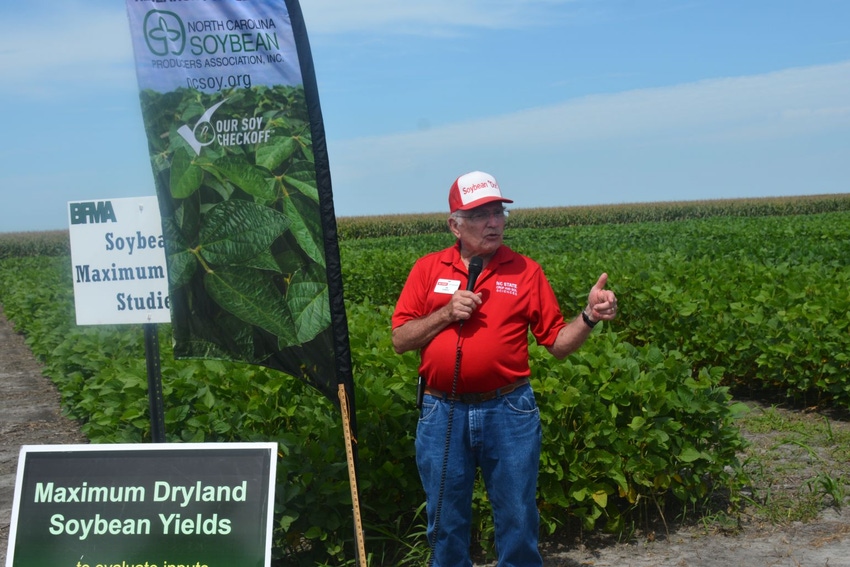
Jim Dunphy says the goal of his maximum-yield soybean trial is to provide a different approach to evaluating inputs.
“It’s not quite a quite kitchen sink approach. We didn’t throw everything at it except the kitchen sink and hope yields came out well. We restricted it to things that we thought would improve yield. We tried to set up as high as yielding environment that we can without irrigation,” Dunphy, the North Carolina State University Extension soybean specialist explained at this year’s Blacklands Farm Managers Tour at Green Valley Farms near Columbia, N.C.
Standing in front of his maximum yield plot at Green Valley Farms that looked excellent in early August thanks in part to timely rain, Dunphy outlined his “Cadillac treatment” for achieving maximum dryland yields to the field day attendees. Variety selection, planting date, plant population, plant height, row width, seed treatments, fungicide and fertility all are vital elements.
In his maximum yield research at Green Valley Farms and three other locations across North Carolina, Dunphy selected the highest yielding Group V and Group VI varieties that work well in a 60-bushel-per-acre environment. He wanted to plant by May 30, but the weather didn’t cooperate, so he planted on June 7.
“I wanted to plant them early enough to get them big enough,” Dunphy said. “Group Vs and Group Vs planted in May are probably a pretty safe bet. Can we get away with early June? Probably.”
Dunphy emphasized the importance of plant height, with the goal of the plants reaching 36 inches high. This height allows soybeans to capture as much sunlight as possible. Dunphy explained that 36-inch-tall plants provides four layers of leaves per layer of ground or four acres of leaves per acre of ground.
“If I have plants that are less than three feet tall, that’s bad; I’m giving up yield. If they are only 24 inches tall I’m giving up yield. I’m not capturing as much sunlight as soybeans know how to capture. I don’t have enough leaves there to do it,” Dunphy said.
What if the soybean plants are four feet tall or five feet tall? Is that any better?
Dunphy says no because you can only get light three feet deep in the canopy. That’s why plants that are three feet tall do the best.
Dunphy wanted to plant 15-inch rows or at least keep the rows under 20 inches. He wanted a plant population of 120,000 plants per acre and was willing to go down to 90,000 seeds per acre on some of the better fields. “I don’t want to feed any more plants than I have to, but I want to feed as many as it takes to maximize yields,” Dunphy said.
He used Poncho/ VOTiVO as a seed treatment and EverGol as a fungicide treatment. He also used the seed treatments Optimize and Bio-Forge. “Optimize is a souped-up inoculant and Bio-Forge is a fertilizer material,” Dunphy explained, noting that top soybean farmers Kip Cullers of Missouri, Randy Dowdy of Georgia and David Hula of Virginia all use a fertilizer with their seed treatment.
In the past two years of his maximum yield trials, he added nitrogen, sulfur and potassium and this didn’t show any improvements in yield. This year, he’s looking at magnesium, sulfur, boron and zinc to see if they will boost yields. “I don’t know if that’s the right thing to be looking at, but that’s what we got in there any way,” he said.
Fungicides are critical for achieving maximum yields. At R2 or full bloom, he applied Topguard. Two to three weeks later he applied Quadris Top, and two to three weeks after that he applied Priaxor.
Finally, Dunphy emphasized that it’s not his job as an Extension specialist to tell farmers what to do. “My job is to do the research and educate. It’s your call what to decide what to do and determine what works best on your farm,” he said.
About the Author(s)
You May Also Like






